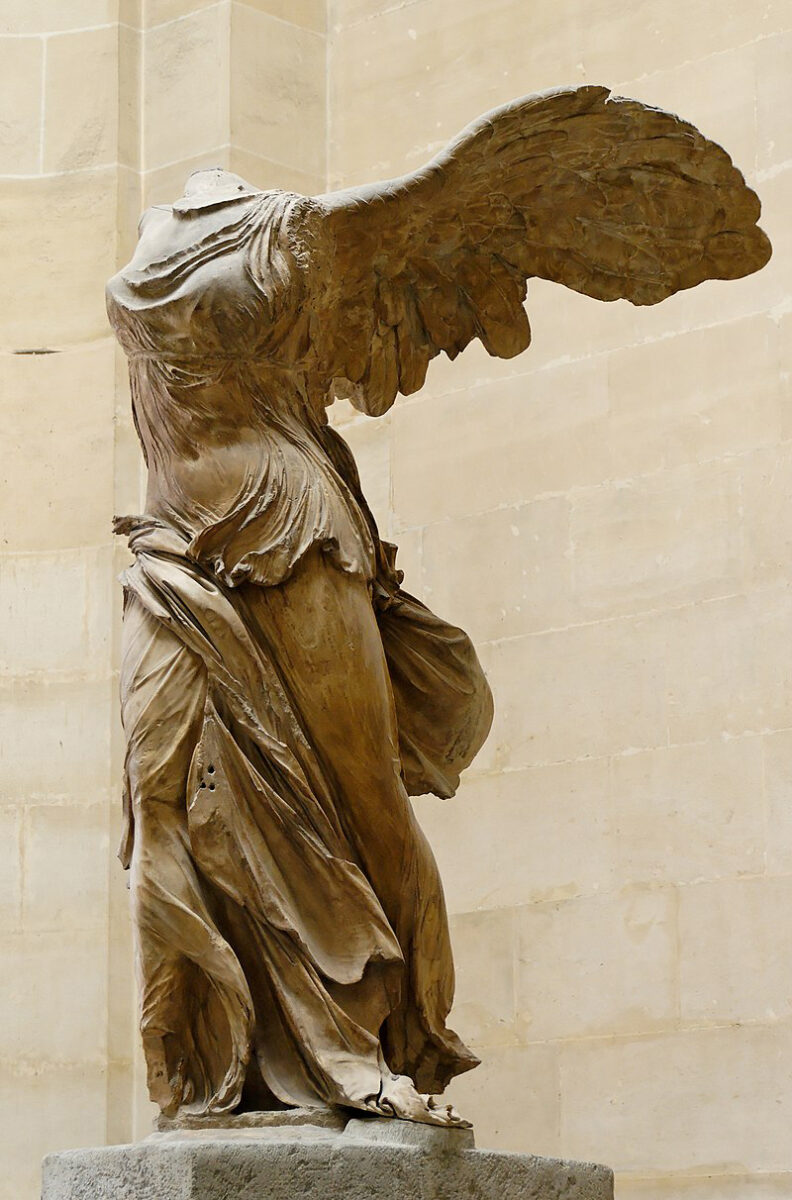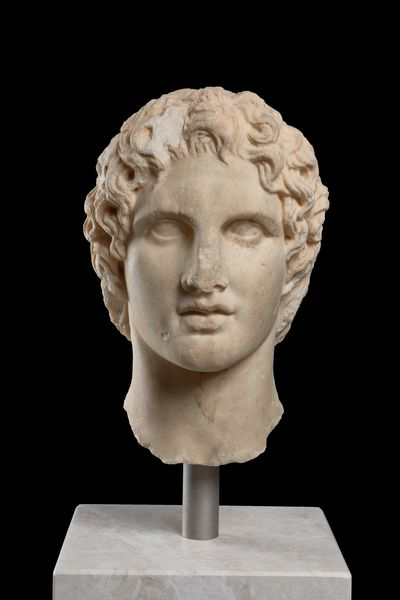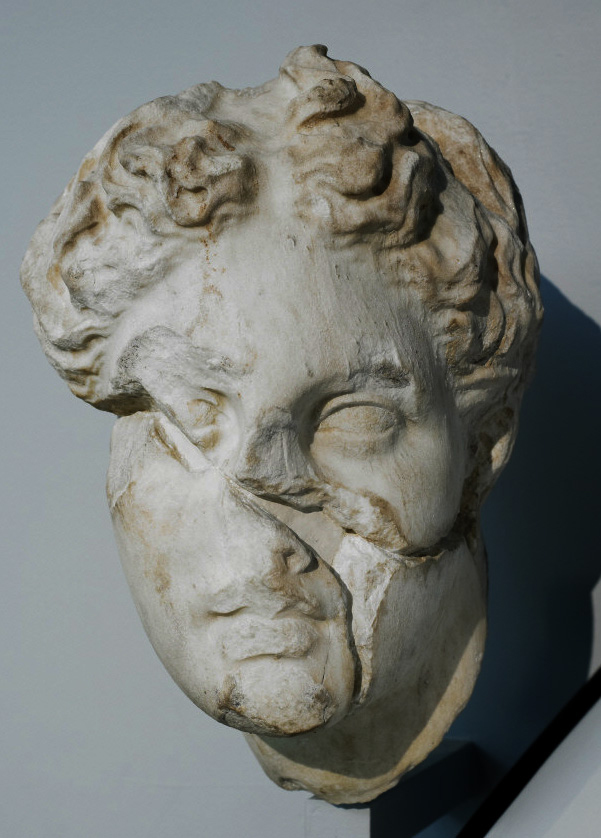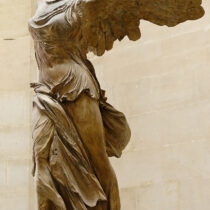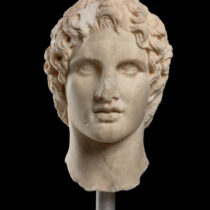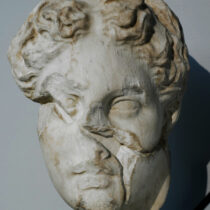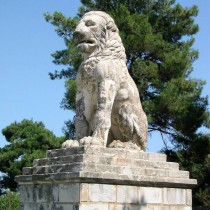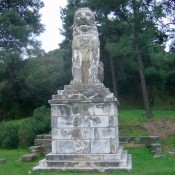An article appeared in the periodical Ανθέμιον, volume 30 (2020), pages 37-45 in which the famous head of Alexander the Great in the Museum of Acropolis (fig. 1), which is usually dated in the 330s BC and attributed to Leochares, is re-dated in the advanced 2nd c. BC. I am writing this article in order to inform both scholars and the public that this down-dating is not convincing at all.
First of all it is necessary to notice that this head represents Alexander as a still very young sitter, when he was not yet a king (no signs of his status as king are detected).
The anatomical details of this head make it homogeneous with the sculptural creations which usually are attributed to Leochares. In particular, the head of Apollo from the Mausoleum of Halicarnassus (fig. 2) is very close to the Acropolis head of Alexander both for rendering of the face and of the hair as well as for the polishing of the surfaces.
This proximity dates the Acropolis head still in the third quarter of the 4th c. BC, because the above mentioned Apollo head of course shares the date of the Mausoleum around 350 BC. The closeness of these two heads is such to impose the necessary conclusion that they both come from the same workshop: this workshop can be only that of Leochares who both worked for the Mausoleum, as we know from Vitruvius and Pliny, and made portraits of the Macedonian royalty.
The message of the Acropolis head is also important: this is the only portrait of Alexander in which the future ruler of the world looks calm and relaxed. The eyes are not yet the spirited, dreamy and excited eyes which will characterize forever the portraiture of this king, from his portraits by Lysippus and Apelles onwards, that is from the late 330s BC.
You understand from this quiet and serene head which was the hope or rather the wishful thinking of the Athenians after their defeat at Chaeronea: that this prince would leave the life of the Greek poleis as it was, respecting their autonomy and without absolutistic aims.
This portrait is understandable only in the context of the atmosphere of the new comedy: the desire and ideal of a bourgeois life, in which the standard components of a society never change and even the king protects this conservative program.
Thus this portrait can be dated only between the battle of Chaeronea of 338 and Alexander’s accession to the throne in 336 BC: it is the most eloquent testimony to the illusions of the Athenians at the time.
A date in the advanced 2nd c. BC is just impossible. First of all at the time the Athenians nourished very bad feelings toward the Macedonians and were not very interested to the figure of Alexander. The Romans were equally very hostile to the Macedonians: the ‘imitatio Alexandri’ by Roman generals begins only with the eastern campaigns of Sulla and even more of Lucullus and Pompey.
Moreover the conquests of Alexander overshadowed completely the image of him as a young prince: from 334 BC, date of the Granicus’ group by Lysippus until the end of antiquity, Alexander will be represented as the king whose daring and bold attitude is always detected on his eyes as well as on the posture of his head. A portrait of Alexander as a young boy dedicated in the Acropolis of Athens at the time does not make any sense.
From a formal point of view it is impossible to detect in this head any feature of the middle Hellenistic baroque: this head does not reveal the nervous and unstable configuration of so many baroque creations. It is 100 % classic, not classicistic. I hope that this demonstration liquet.
The Ministry of Culture and Sports and the National Archaeological Museum just published a book – Known and Unknown Nikai, Athens (2021) – which includes an article devoted to the Nike of Samothrace (pages 148-169) (fig. 3).
In this article it is asserted that this Nike was the Roman dedication for their victory against Macedon in 168 BC. The third Macedonian war was fought only on land, not in the sea. Thus the idea that a Nike on the prow of a ship celebrates a land victory is so illogical that it should have never been published.
This article is made really bad also because it has two very ugly mistakes. The first mistake is the idea that from 168 BC Samothrace was under Rome. That is just not true. After the third Macedonia war, Samothrace became an independent state. Rome had not gained an inch of land in the north Aegean area after this victory. The Romans created small states which had not the power to revolt against their superpower. They even allowed anti-Roman elites to take power in these tiny countries because they paid little attention to their internal affairs, so far that when in 150/149 BC Andriscus promoted an anti-Roman war, most Greek states joined this crusade.
The second unbelievable mistake is the notion that Perseus surrendered on Samothrace. That is just not true. Perseus surrendered to Aemilius Paullus at Amphipolis.
The sequence of what happened after the Roman land victory at Pydna is narrated analytically by Livy in the 44th and 45th books of his history. I summarize these events here.
After the defeat at Pydna, Perseus escaped (Livy 44. 42), first of all to the Pierian forest, but intending to go to Amphipolis (44. 43). However the news of the Roman victory had already been carried to Amphipolis and the Amphipolitan matrons flocked to the temple of Artemis Tauropolos. Diodorus, the governor of Amphipolis, delivered a talk in the agora of Amphipolis and found an excuse to send away the Tracian garrison, strong of 2000 soldiers, then he shut the gates of the city (44. 44). Three days after his defeat, Perseus arrived to Amphipolis: he came before the assembled citizens of Amphipolis, trying to gain their support, but the Amphipolitans told him to leave the city. Then Perseus retired to his palace at Amphipolis [perhaps to be identified with the excavated Hellenistiki Oikia?] and after placing his gold and silver on some boats lying in the Strymon, went down the river, reaching Galepsos and then Samothrace (44. 45). In the meantime a small detachment of Romans was sent to Amphipolis, then the consul after few days arrived at Amphipolis: the whole population of Amphipolis came out to meet him (44. 46). The first three chapters of book 45 report on the joy felt at Rome at the news of the victory. Then Perseus from Samothrace sent two letters to Aemilius Paulus at Amphipolis appealing for mercy and asking him to send some persons with whom he could confer as to his status. The consul sent three Romans to him, but nothing resulted from the conference (45. 4).
Octavius puts in at Samothrace. An assembly of the people on Samothrace asked Euander, companion of Perseus, either to stand trial for the charge of murder or to leave the island. Perseus puts Euander to death and then told the chief magistrate of the island that Euander took his own life (45. 5).
Then Perseus asked a Cretan man with a boat to take him on board to the Thracian king Cotys. This Cretan man accepted the offer and waited until the money of the king was on board, then he sailed without Perseus. Then Perseus, left with no alternative, handed himself over to Octavius (45. 6).
What follows deserves to be quoted, not just cited (Livy 45. 6. 11-9. 1): ‘The fleet at once sailed back to Amphipolis. From there Octavius sent the king to the consul’s camp, having previously advised him that the king was being brought to his camp as a prisoner. Paulus regarded the capture of the king as a second victory, as it really was, and on receiving the news offered sacrifices. He then called his council together and read the praetor’s despatch to them. Q. Aelius Tubero was sent to meet the king, the rest were ordered to remain together at the headquarters tent. Never has so great a crowd been brought together at any other sight. In the time of our fathers Syphax was brought as a captive monarch into the Roman camp. But he is not to be compared with Perseus in respect either of his own renown or that of his nation, and besides, he had only played a subordinate part in the Punic War, as Gentius had done in the Macedonian. Whereas Perseus was the head and supreme director of the war; and not only were all eyes drawn to him through his own reputation and that of his father and grandfather and others to whom he was allied by blood relationship, but he was heir to the glory of Philip and Alexander the Great, who raised the Macedonian Empire to a supreme position in the world. Perseus entered the camp in mourning garb without a single attendant to make him more pitiable by sharing his misfortunes. His only companion was his son. Owing to the crowd who surrounded him he was unable to make any progress until the consul sent his lictors to clear a passage for him to the headquarters tent. After asking the rest to keep their seats the consul went forward a few steps and held out his hand to the king as he entered, and when he was going to prostrate himself he raised him to his feet and would not allow him to embrace his knees as a suppliant. Once inside the tent, he bade him take his seat facing the members of the council. The first question put to him was what wrongs had he suffered which compelled him to commence war against Rome in such an aggressive temper and so imperil his own existence and that of his kingdom? Whilst all were waiting for his answer, he kept his eyes fixed on the ground and wept for some time in silence. Then the consul continued: “Had you received the crown in your youth I should be the less surprised at your not knowing what weight Rome possesses either as a friend or an enemy. But now, after having been associated with your father in his war against us and in the peace which followed, and which you well remember we kept with perfect good faith towards him, what could have been your object in choosing war rather than peace with those whose strength you have felt in war and whose fidelity you have experienced in peace?” He made no reply to either the question or the charge. Then the consul said: “Well, however this may have been brought about, whether through the blindness of human nature or through chance, or through the decree of Fate, keep a stout heart. The clemency of the people of Rome, which has been shown in the misfortunes of many kings and nations, affords you not only a hope, but a tolerably certain guarantee of your personal safety.” He said this in Greek to Perseus, and then turning to the council he said in Latin, “You see a striking example of the mutability of human affairs. Especially to you younger men am I now speaking-it does not become us, therefore, in the hour of prosperity to form any aggressive designs against anyone, or to trust the fortune of the moment, for it is uncertain what the evening will bring. He only will prove himself a man whose spirit is not elated by the breath of prosperity nor broken by the blasts of adversity.” When the council had broken up, the custody of the king was entrusted to Q. Aelius. On that day he was invited to dine with the council, and every mark of honour was shown to him which could be shown to any one in his position. After this the army went into winter quarters. Amphipolis took in the greater portion.’
It is clear that Amphipolis, where the king tried to resist the Romans and where Aemilius Paullus established his headquarter and received the surrender of Perseus, was the crucial centre of this episode. Perseus made only a short stopover on Samothrace in his attempt to reach Thrace and his allied king Cotys.
Had the Romans decided to set up a statue at the very spot of the surrender of Perseus they would have erected it at Amphipolis, not on Samothrace.
Antonio Corso
